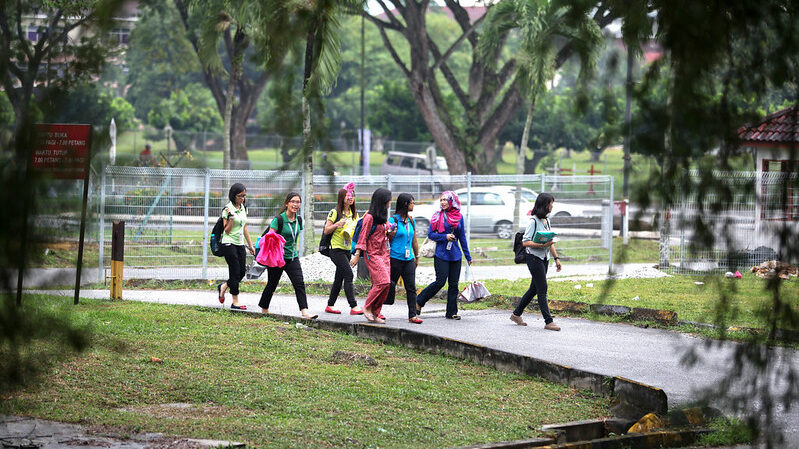
According to the International Labour Organisation (ILO), not all work done by children is classified as child labour. Child labour is defined as “work that deprives children of their childhood, their potential and their dignity, and is harmful to physical and mental development.”1
In other words, work can be positive to children’s development, so long as it falls within certain limits. Specifically, the work cannot negatively affect children’s mental, physical, social, or moral development and cannot interfere with schooling.
In Malaysia, the minimum age to work full-time is 15 years, and 13 years is the minimum age for light work (Section 2(2A) (Act A1586)). Malaysia’s National Action Plan Against Forced Labour (NAPFL) adopts ILO’s definition of child labour.
The following table outlines the restrictions in place in Malaysia to ensure children and youth stay out of child labour situations:2
| AGE 13 TO <15 YEARS | 15-17 YEARS OLD |
|---|---|
| Can only engage in light work. | Only engage in non-hazardous work. |
| Not allowed to work between 20:00-07:00. | Not allowed to work between 20:00-06:00. |
| Not allowed to work for more than 3 consecutive hours without a minimum 30-minute break. | Not allowed to work more than 4 consecutive hours without a minimum 30-minute break. |
| Not allowed to work more than 6 hours a day. | Not allowed to work more than 7 hours a day. |
| Not allowed to work more than 7 hours including school hours. | Not allowed to work more than 8 hours including school hours/apprenticeship contract. |
| Not allowed to work more than 6 days a week. | Not allowed to work more than 6 days a week. |
Unfortunately, child labour persists everywhere in the world, despite most countries establishing minimum working ages and other restrictions. In interviews with MY Voice, civil society and workers’ organizations, in Malaysia shared that children can be found in palm oil plantations and smaller farms assisting their parents or employed in hazardous work, such as slashing, harvesting, loading and spraying.3 Child labour can also be found in other industries, particularly in the service sector in urban areas and in the fishing industry along Malaysia’s coasts. Child labour risks are heightened by poverty and by complex migration dynamics in Malaysia, including lack of documentation among some Indonesian and Filipino descendants.4 Children who live in poverty often start working at an early age in roles and in conditions that are detrimental to their healthy development.
When child labour is discovered, the first priority should be to protect the wellbeing of the child through a supportive remediation process. At this time, Malaysia does not have a formal child labor remediation program implemented by the government or private sector. While there are pathways to hold employers that violate child labor laws accountable under the Children and Young Persons Employment Act 1966 (amendment 2019),5 there are no stipulations for protective actions to support the child.
In response to this gap, MY Voice is working to establish Malaysia’s first Multi-Stakeholder Child Labour Remediation program. Learn more about this exciting initiative.
- ILO: International Programme on the Elimination of Child Labour – https://www.ilo.org/ipec/facts/lang–en/index.htm ↩︎
- Work that contradicts any provision under the Factories and Machinery Act 1967, the Occupational Safety and Health Act 1994 (only in CYPA), and the Electricity Supply Act 1990 is prohibited. However, there are exceptions if the person is receiving a course of instruction at a government technical school or other educational institution or is serving a recognized apprenticeship. The list of hazardous work is provided in Schedules Four and Five of the Children and Young People (Employment) (Amendment) Act 2019, which applies to Peninsular Malaysia only. ↩︎
- Wahab, Andika. (2021). Understanding Children Assisting Parents, Working Children and Child Labour in the Palm Oil Sector in East Malaysia (Sabah). 10.13140/RG.2.2.25408.87048. ↩︎
- Wahab (2021) ↩︎
- The 2019 amendment by the Federal Government does not apply to Sabah. Only, Sabah Labour Ordinance (Section 73) applies. Conviction to imprisonment for a term not exceeding two years or to a fine not exceeding fifty thousand ringgit or to both and, in the case of a second or subsequent offence, shall be liable on conviction to imprisonment for a term not exceeding five years or to a fine not exceeding one hundred thousand ringgit or to both [Act 350 Children and Young Persons Employment Act 1966] ↩︎
